In the beautiful land of Salento, rich in history and traditions, clocks are not just tools to measure time, but authentic testimonies of the past. For centuries, towers and bell towers adorned with majestic dials have marked the rhythm of daily life, representing a deep connection between the land and its communities. Crafted by skilled watchmakers or integrated into extraordinary architectures, these clocks reflect a cultural heritage that combines functionality, beauty, and historical memory.
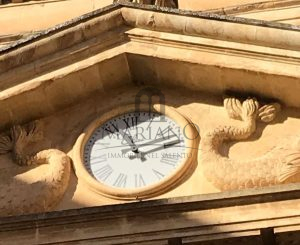 Through a journey to the most iconic places of Salento, we will discover how these timepieces tell stories of ingenuity, art, and identity, linking the past and present in a timeless narrative.
Through a journey to the most iconic places of Salento, we will discover how these timepieces tell stories of ingenuity, art, and identity, linking the past and present in a timeless narrative.
The clockmaking tradition of Salento stands out for its unique ability to combine the art of measuring time with a profound sense of territorial identity. In addition to the monumental clocks that decorate towers and churches, Salento has seen the rise of skilled watchmakers, including Giuseppe Candido, an emblematic figure in the art of watchmaking in Lecce.
Giuseppe Candido, active between the 19th and 20th centuries, was one of the most famous watchmaking craftsmen in the region. His craftsmanship and innovation left an indelible mark on the city of Lecce, where he created clocks that became true symbols of the city.
Candido was also distinguished for creating public and tower clocks, which not only served their function of telling the time but also enriched buildings with ornamental details and complex mechanisms. His works were the result of a perfect synthesis between mechanical functionality and aesthetics, reflecting the Baroque style of Lecce and the Salentine craftsmanship tradition.
In the splendid Piazza Sant’Oronzo in Lecce, stands a tower with a majestic clock, known as the “Clock of Wonders.” Created in 1955 by the watchmaker Francesco Barbieri, this work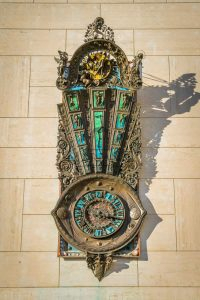 represents a blend of modernity and Baroque tradition, with details that evoke astrology, tarot, and Salentine symbolism. Despite the passage of time, the clock was recently restored and regained its former splendor, once again shining as one of the most significant symbols of the city.
represents a blend of modernity and Baroque tradition, with details that evoke astrology, tarot, and Salentine symbolism. Despite the passage of time, the clock was recently restored and regained its former splendor, once again shining as one of the most significant symbols of the city.
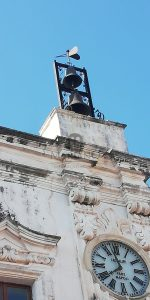 The civic tower of Nardò, with its precision clock, has regulated the life of the community for centuries. The clock is not just a timepiece, but a true testament to the ability of Salentine watchmakers to merge technique and art. It is one of the most significant examples of the history of watchmaking in Salento.
The civic tower of Nardò, with its precision clock, has regulated the life of the community for centuries. The clock is not just a timepiece, but a true testament to the ability of Salentine watchmakers to merge technique and art. It is one of the most significant examples of the history of watchmaking in Salento.
Located in the main square of Galatone, the tower houses a clock that has marked time for generations. This structure is a symbol of a deep connection between the city’s historical past and its clockmaking tradition, continuing to serve as a point of reference for the locals.
The bell tower of the Cathedral of Sant’Agata in Gallipoli is an important landmark of the city, and inside, it houses both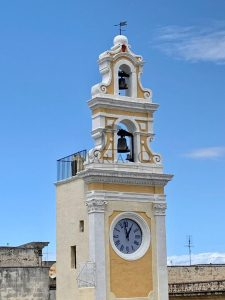 a clock and a sundial. The clock, located on the bell tower’s facade, has marked the time accurately for centuries and is a fundamental part of the city’s life. The sundial, also part of the tower, is an ancient instrument that measures time through the shadow cast by a gnomon on the surface below, serving as a reminder of traditional methods of observing the passage of time. Both instruments, the clock and the sundial, represent not only the functionality and ingenuity of past times but also a symbol of Gallipoli’s history, where the measurement of time merges with the city’s religious and cultural tradition.
a clock and a sundial. The clock, located on the bell tower’s facade, has marked the time accurately for centuries and is a fundamental part of the city’s life. The sundial, also part of the tower, is an ancient instrument that measures time through the shadow cast by a gnomon on the surface below, serving as a reminder of traditional methods of observing the passage of time. Both instruments, the clock and the sundial, represent not only the functionality and ingenuity of past times but also a symbol of Gallipoli’s history, where the measurement of time merges with the city’s religious and cultural tradition.
 The clock at the municipal headquarters in Maglie, located on the facade of the main building of the town hall, is a highly valuable historical and symbolic element for the city. This clock, which has marked the time for decades, represents an important point of reference for the local community. Its location, easily visible from the main square, makes it a symbol of city life and the Magliese tradition. The clock not only serves its practical function of measuring time but is also integrated into the historic architecture of the town hall, contributing to defining the identity of the place. Like many public clocks in Salentine cities, the one in Maglie is a testament to the city’s evolution and the central role of the town hall in the daily life of the community.
The clock at the municipal headquarters in Maglie, located on the facade of the main building of the town hall, is a highly valuable historical and symbolic element for the city. This clock, which has marked the time for decades, represents an important point of reference for the local community. Its location, easily visible from the main square, makes it a symbol of city life and the Magliese tradition. The clock not only serves its practical function of measuring time but is also integrated into the historic architecture of the town hall, contributing to defining the identity of the place. Like many public clocks in Salentine cities, the one in Maglie is a testament to the city’s evolution and the central role of the town hall in the daily life of the community.
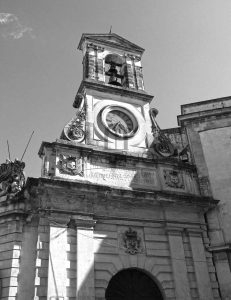 The clocks of the Civic Towers of Galatina and Noha are historical and cultural symbols of their respective communities. The clock of the Civic
The clocks of the Civic Towers of Galatina and Noha are historical and cultural symbols of their respective communities. The clock of the Civic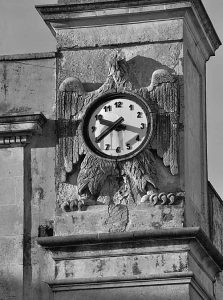 Tower of Galatina, built in the 14th century, has marked time for generations, becoming a visible landmark from the city. Similarly, the clock of the Civic Tower of Noha, located in the district of Galatina, is a central element in the life of the village, tied to local tradition and history. Both clocks continue to witness the passage of time and represent the connection to the past of the Salentine communities.
Tower of Galatina, built in the 14th century, has marked time for generations, becoming a visible landmark from the city. Similarly, the clock of the Civic Tower of Noha, located in the district of Galatina, is a central element in the life of the village, tied to local tradition and history. Both clocks continue to witness the passage of time and represent the connection to the past of the Salentine communities.
In Poggiardo, the bell tower of the church hosts a clock that has always been one of the distinguishing features of the town. Like the other clocks of the Salentine towers, this clock has marked the lives of the residents, setting the rhythm of the days and holidays. Its prominent position and precision mechanics make it a symbol of local tradition.
The clock of the Civic Tower of Casarano stands tall over the main square, uniting the history of the city with its community spirit. For centuries, the clock has marked the life of the people of Casarano, becoming an emblematic element of the city. The tower, with its clock, represents a connection between the past and the present, a symbol of continuity for the community.
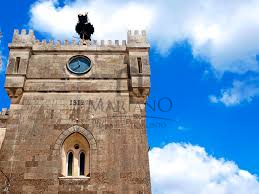 The clock of the Carpignano Tower, located on one of the medieval towers of the town, is another example of the Salentine clockmaking tradition. For generations, its sound has marked the beginning and end of the day, becoming a symbol of the bond between the people of Carpignano and their history. The Serrano Tower also hosts a clock that has been part of the daily life of the small community for generations. Like the other public clocks of Salento, this clock represents an integral part of the local tradition and continues to keep the memory of the past alive, marking the passage of time with punctuality and precision.
The clock of the Carpignano Tower, located on one of the medieval towers of the town, is another example of the Salentine clockmaking tradition. For generations, its sound has marked the beginning and end of the day, becoming a symbol of the bond between the people of Carpignano and their history. The Serrano Tower also hosts a clock that has been part of the daily life of the small community for generations. Like the other public clocks of Salento, this clock represents an integral part of the local tradition and continues to keep the memory of the past alive, marking the passage of time with punctuality and precision.
The monumental clocks of Salento are not just tools but authentic symbols that unite the past, present, and future. Their beauty, combined with technical precision and the skill of local artisans, makes these works a heritage that deserves to be preserved and enhanced. Each clock tells a story of art, culture, and ingenuity, linking the Salentine community to its history and traditions.
Whether it’s a tower overlooking a square or a clock adorning a historical building, each mechanism represents a chapter in the history of Salento, written with the skill of clockmakers like Giuseppe Candido, whose work continues to live through these extraordinary clocks that mark time with elegance and mastery.



